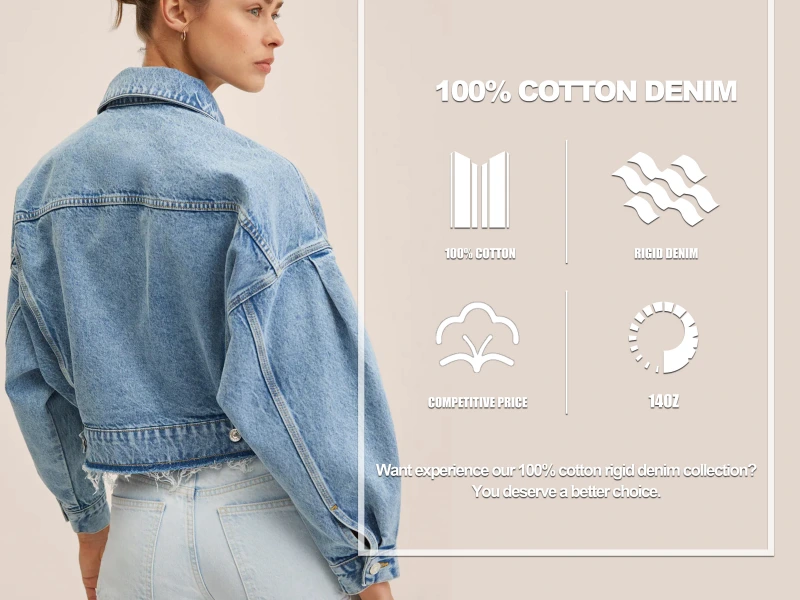The durability and rugged charm of heavy denim have created a cult following, with enthusiasts seeking out vintage heavy denim pieces or embracing raw denim, which ages uniquely with wear. Today, heavy denim remains an integral part of fashion, offering a combination of functionality, style, and authenticity that appeals to a wide range of individuals.
Let’s talk about from following:
- What is Heavy Denim Fabric?
- The Manufacturing Process of Heavy Denim Fabric
- Advantages of Heavy Denim Fabric
- Heavy Denim Fabric in Fashion
- Maintenance and Care Tips for Heavy Denim Fabric
What Is Heavy Denim Fabric?
- Introduction to Heavy Denim Fabric
Denim fabric is widely recognized for its durability, strength, and timeless appeal. However, within the realm of denim, there exists a distinctive variant known as heavy denim. This type of denim fabric, as the name suggests, is known for its substantial weight, making it a robust and hard-wearing choice for various garments. This guide provides an overview of heavy denim fabric, delving into its definition, key characteristics, as well as its historical background and popularity.
- Definition and Characteristics
Heavy denim fabric can be defined as denim that weighs significantly more than standard denim. It is typically woven with a higher thread count and a thicker cotton yarn compared to regular denim. As a result, heavy denim exhibits exceptional sturdiness and a substantial feel. The weight of the fabric is typically measured in ounces per square yard (oz/yd²), with heavy denim ranging from around 12 oz/yd² to 24 oz/yd² or even higher. This weight provides a denser and more robust fabric that offers enhanced durability and longevity.
- Historical Background and Popularity
The history of heavy denim fabric dates back to the late 19th century when it gained popularity among workers in industries such as mining, construction, and railroad. These workers required clothing that could withstand demanding physical labor, and heavy denim proved to be a reliable choice. Over time, heavy denim became synonymous with workwear due to its ability to endure harsh conditions.
In the mid-20th century, heavy denim started appearing in the realm of fashion, becoming a symbol of rebel culture and countercultural movements. Icons like James Dean and Marlon Brando popularized heavy denim jeans, giving birth to the concept of the quintessential “American cool.” The popularity of heavy denim continued to grow throughout the decades, with designers and brands incorporating it into their collections, resulting in its widespread use in contemporary fashion.
The Manufacturing Process of Heavy Denim Fabric
- Selection and Preparation of Cotton
The manufacturing process of heavy denim fabric starts with the careful selection and preparation of cotton. Typically, long-staple cotton fibers are chosen due to their strength and ability to withstand the rigorous weaving process. These fibers undergo a thorough cleaning and are then straightened, carded, and spun to create yarns of the desired thickness and quality.
Indigo dyeing is a crucial step in creating the iconic blue color of denim fabric. Heavy denim undergoes a meticulous dyeing process using natural indigo dye, which imparts a deep blue hue to the fabric. The yarns are dipped multiple times into the indigo dye bath, allowing them to absorb the color. After each dip, the yarns are left to oxidize, which turns them from a greenish-yellow shade to the desired blue. This process is repeated until the desired shade of blue is achieved.
- Weaving Techniques for Heavy Denim
The weaving process for heavy denim fabric involves using specialized looms and weaving techniques to create a sturdy and dense fabric. The weaving technique commonly employed for heavy denim is known as a twill weave, specifically, the 3×1 or 2×1 twill, which gives the fabric its characteristic diagonal pattern. The twill weave not only provides strength but also contributes to the durability and texture of the heavy denim fabric. Additionally, the tighter weft and warp threads used in heavy denim create a substantial fabric that offers excellent resistance to tearing and fraying.
Advantages of Heavy Denim Fabric
- Durability and Longevity
One of the primary advantages of heavy denim fabric lies in its exceptional durability and longevity. The higher thread count and thicker yarns used in its production make it more resistant to wear and tear, ensuring that heavy denim products endure rigorous use and maintain their structural integrity over time. This durability makes heavy denim an ideal choice for workwear and garments that are subjected to demanding conditions.
- Versatility and Style
Despite its robust nature, heavy denim fabric also offers versatility and style. It can be fashioned into a wide range of garments, from jeans and jackets to skirts and bags. The substantial weight and textured appearance of heavy denim add a unique aesthetic appeal, lending a timeless and rugged charm to any outfit. Whether dressed up or down, heavy denim effortlessly exudes a sense of casual coolness and authenticity.
- Enhanced Protection and Insulation
Another advantageous characteristic of heavy denim fabric is its enhanced protection and insulation. The thickness and tightly woven structure of heavy denim provide a degree of protection against the elements, making it an excellent choice for outerwear and heavy-duty work clothing. Additionally, heavy denim offers excellent thermal insulation, keeping the wearer warm in colder climates. This insulation property, coupled with its durability, makes heavy denim an ideal option for garments designed to withstand challenging environments.
Heavy Denim Fabric in Fashion
- Classic Denim Jeans
No discussion of heavy denim fabric would be complete without mentioning the timeless classic – denim jeans. Heavily woven and durable, heavy denim jeans have been a fashion staple for decades. They offer a rugged and authentic look that can be effortlessly dressed up or down, making them a versatile choice for any occasion. Whether styled with a t-shirt and sneakers for a casual look or paired with a blazer and boots for a more polished ensemble, classic denim jeans made from heavy denim fabric are a must-have in any wardrobe.
- Denim Jackets and Shirts
Denim jackets and shirts are another popular fashion choice made from heavy denim fabric. Renowned for their durability, these garments provide both style and protection from the elements. The heavy denim fabric adds a rugged and textured look to denim jackets, making them perfect for layering in colder weather. Denim shirts made from heavy denim fabric offer a versatile and effortlessly cool option, easily paired with jeans, trousers, or skirts, and suitable for various occasions.

- Denim Accessories and Footwear
Beyond clothing, heavy denim fabric has made its way into the realm of accessories and footwear. Denim bags, such as totes, backpacks, and crossbody bags, made from heavy denim fabric are not only stylish but also sturdy and functional. They can withstand the demands of everyday use while adding a touch of casual sophistication to any outfit. Additionally, heavy denim footwear, such as sneakers and boots, brings a rugged edge to any look. The durability of heavy denim ensures that these accessories and footwear last, making them a practical and fashionable investment.
Maintenance and Care Tips for Heavy Denim
- Washing and Drying Techniques
To maintain the quality and longevity of heavy denim garments, it is important to follow proper washing and drying techniques. Turn the garment inside out before washing to help preserve the color and prevent fading. Use a mild detergent and choose a gentle wash cycle with cold water to minimize wear. When it comes to drying, air drying is the best option to prevent shrinkage and maintain the fabric’s shape and texture. Hanging heavy denim garments on a clothesline or laying them flat to dry is recommended.
- Preventing Fading and Shrinkage
To prevent fading and shrinkage of heavy denim fabric, it is advisable to wash them sparingly. Frequent washing can cause the dye to fade more quickly. When washing heavy denim, avoid using bleach or harsh chemicals that can damage the fabric. Additionally, refrain from using high heat when drying, as it can cause shrinkage. If ironing is necessary, use the lowest heat setting and place a cloth or towel between the iron and the heavy denim fabric to protect it.
- Repairing and Preserving
Heavy Denim Garments If heavy denim garments develop tears or fraying, it is best to repair them promptly to prevent further damage. Patching and darning techniques can be utilized to mend small tears and reinforce weak areas. Additionally, to preserve the original color and texture of heavy denim fabric, store garments in a cool, dry place away from direct sunlight. Avoid folding heavy denim items too tightly to prevent creasing and maintain their shape.
Conclusion
In a words, Whether it’s the iconic jeans, stylish jackets, and shirts, or trendy accessories and footwear, heavy denim fabric has stood the test of time and continues to be a favorite among fashion enthusiasts. Its ability to adapt to different styles and occasions makes it a versatile and dependable fabric. From its origins as workwear to becoming a symbol of rebellious fashion, heavy denim has become an essential part of our wardrobes.





